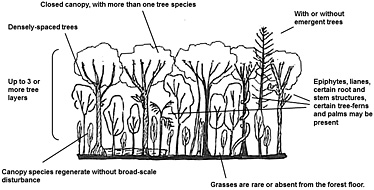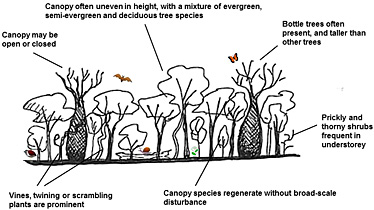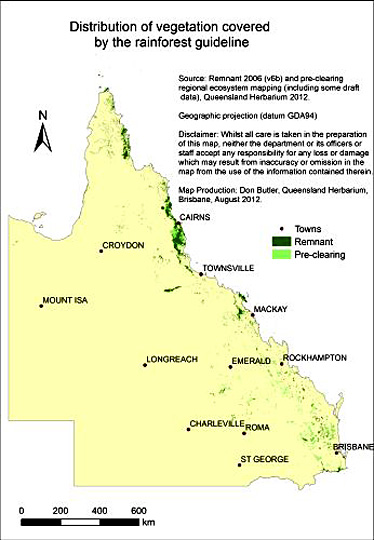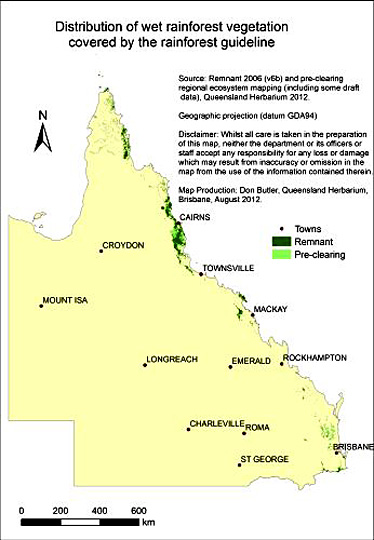Description
What is it?
Rainforest is a forest type dominated by trees tolerant of shade and sensitive to fire. The wetter types of rainforest tend to have densely-spaced trees and closed tree canopies that block most of the light. The forest floor is shady, and light-loving plants such as grasses and eucalypts are rare or absent. There are often many different species of canopy trees, and palms, ferns, vines and epiphytes (air plants) may be abundant.
In Queensland, rainforest includes wet rainforest and dry rainforest (some of which are also known as vine-thicket or softwood scrub).
Where is it?
In Queensland, remnants of the wetter types of rainforest are found along the east coast, and associated with the Great Dividing Range. Drier types of rainforest can be found in these areas, but are also found further inland in fire-protected areas that receive an average of at least 600mm of rainfall a year.
Carbon potential
Based on sites in Queensland, wet rainforest has the potential to store from 300 to more than 1700 tonnes of carbon dioxide equivalent per hectare, and dry rainforest has the potential to store from 170 to more than 800 tonnes of carbon dioxide equivalent per hectare.
The maximum accumulation rate of wet rainforest can exceed fifteen tonnes per hectare of carbon dioxide equivalent per year, while the rate is likely to be slower for dry rainforest.
Read more about farming carbon and limits to carbon accumulation.
Restoration and management
Temperature, moisture, soil fertility and drainage have a strong influence on the carbon accumulation rates and standing carbon stocks in rainforest, however management can also have a large effect.
Weeds, fire, vines, grazing pressure and seed limitation can all limit the establishment and growth of rainforest plants. So careful management of these threats is required in the early stages of restoration.
Wildlife
Restoring rainforest will be of great benefit to biodiversity, as rainforests are famously diverse ecosystems and support a high number of plant and animal species.
Features
Rainforest includes wet rainforest and dry rainforest (which includes vine-thickets or softwood scrubs).
Wet rainforests and dry rainforests merge together where average annual rainfall is between 1000mm and 1400mm, and in many cases may not easily be distinguished. Dry rainforest may occur in fire-protected areas where average annual rainfall is at least 600mm.


Wet rainforest
Mature wet rainforest in Queensland has the following features:
- The tree canopy is comprised of more than one tree species, and these species are often sensitive to fire.
- Canopy cover is generally closed (more than 70% cover).
- Many canopy tree species are shade-tolerant, and can regenerate without requiring broad-scale disturbance such as fire.
- Trees are densely spaced, in contrast to more open eucalypt forests.
- There can be up to 3 or more tree layers, with or without emergent trees.
- Epiphytes (air plants), vines, certain root and stem structures (e.g. buttresses), tree ferns and palms may be present.
- There can be wide variation in the species of canopy trees and other plants, which may relate to the local climate, soil type, elevation, drainage and management history of the site.


Dry rainforest
Mature dry rainforest in Queensland has the following features:
- The tree canopy is usually comprised of more than 1 tree species, and these species are often sensitive to fire.
- Canopy cover may be open or closed (greater or less than 70% cover).
- Canopy tree species don’t require broad-scale disturbance, like fire, to regenerate. Many plant species can regenerate by resprouting.
- The tree canopy is often uneven in height (typically 4–20m), and there may be a mixture of evergreen, semi-evergreen and deciduous tree species.
- Vines, twining or scrambling plants are prominent.
- Trees with 2.5–7.5cm long leaves are prominent.
- Trees that are 9m to 35m tall commonly occur above the main tree canopy (e.g. bottle trees, hoop pine, ooline).
- Prickly and thorny species are common in the shrub understorey.
More information
View the Rainforest Management Guideline .





